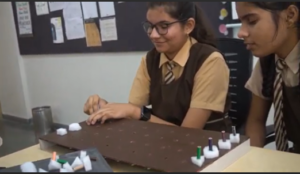In today’s world, education is at a crossroads. Traditional systems often focus on theoretical knowledge, leaving students with limited real-world problem-solving skills. Meanwhile, pressing global challenges demand individuals who can think critically, empathise deeply, and innovate boldly.
Imagine a visually impaired child longing to play games with their peers, yet unable to do so because traditional games aren’t designed with them in mind. At Keystone International School, our Grade 2 students took it upon themselves to change this reality. This community-driven problem-solving is at the heart of the ‘Idea Loom framework’.
The Idea Loom framework is designed as a structured approach to equip students with the ability to engage deeply with communities, identify real-life challenges, and develop meaningful, sustainable solutions through practical methodology.
Students Need a Future-Oriented Education
Education often operates in silos: subjects are taught separately, assessments emphasise memorisation, and students rarely experience the messy, unpredictable nature of real-world challenges. This disconnect leaves students underprepared for careers and lacking a sense of personal fulfillment in a world that rewards creative thinking and adaptability.
Imagine a different kind of education—one where students don’t just learn about problems but actively work to solve them. Imagine an education where students don’t just write essays on social issues but create technology-driven solutions to transform lives. That’s what Idea Loom brings to the table: an education rooted in action, empathy, and innovation.
How the Idea Loom Framework Redefines Education
At its core, Idea Loom is a structured problem-solving framework that encourages students to become active contributors to society. It enables them to take ownership of real-world issues and drive impactful change through five focus areas:
- Empathy-Driven Problem Identification: Students engage directly with communities to understand pressing challenges, conducting research, interviews, and field visits.
- Collaborative Innovation: Working in diverse teams, students ideate and co-design solutions, integrating perspectives from multiple disciplines like STEM, social sciences, and the arts.
- Hands-On Prototyping & Testing: Learning through doing, students create, test, and refine physical and digital prototypes, applying engineering, design, and technology to build impactful solutions.
- Real-World Implementation: Projects are not just theoretical; students deploy and test solutions in actual environments, gather community feedback, and refine their work for continuous improvement.
- Mentorship & Industry Collaboration: With support from experienced professionals across various fields, students gain valuable insights and guidance to develop solutions with lasting impact.
“These projects are not hypothetical classroom exercises—they are real solutions making a difference in people’s lives. Through Idea Loom, students are redefining what education should be: an active force for change.”
Transforming Student Learning into Tangible Change
Beyond creating solutions, the Idea Loom framework instils confidence and leadership in students. Through real-world application, they develop resilience, adaptability, and a deeper sense of responsibility. Many students have reported that working on these projects has not only improved their problem-solving skills but also given them a newfound sense of purpose.
TouchPlay: A Board Game for the Visually Impaired (Grade 2 students, 2024)
After visiting Devnar School for the Blind, Keystone Grade 2 students observed that visually impaired children had limited options for recreational activities. This realisation inspired them to design TouchPlay, an innovative tactile board game that engages players through touch, allowing visually impaired individuals to enjoy gaming independently.

- Impact: This game fosters independent play, cognitive development, and inclusivity, bridging the gap between visually impaired and sighted players.
- Future Developments: The students aim to expand TouchPlay’s features, incorporating more textures and sharing it with schools for the blind and wider organisations to promote accessibility in play.
Ultrasonic Cane Attachment: Empowering the Visually Impaired (Grade 7 students, 2024)
Grade 7 students took on the challenge of helping visually impaired individuals navigate their surroundings safely. Their solution? An ultrasonic attachment for a white cane which detects obstacles and provides real-time voice alerts through a headset.
- Impact: This device enhances mobility, independence, and safety, reducing navigation anxiety among users.
- Future Developments: The team plans to integrate Bluetooth technology to connect the device with a smartphone app for additional functionality.

Students work hand-in-hand with communities to identify problems and co-design solutions. Through partnerships with Bala Vikasa, T-Works, The Alliance for Sustainable Schools (TASS), and professionals from various industries, students gain access to real-world insights, mentorship, and resources that enrich their learning. These collaborations ensure that the projects developed truly serve the needs of society.
These projects are not hypothetical classroom exercises—they are real solutions making a difference in people’s lives. Through Idea Loom, students are redefining what education should be: an active force for change.
Practical Takeaways for International School Leaders
For schools looking to implement Idea Loom, customisation is key. The framework is adaptable across various educational settings, allowing institutions to modify its components to best fit their students’ needs. Whether integrating it into an existing curriculum or using it as a standalone initiative, schools can tailor Idea Loom to their unique educational goals.
Here are some recommendations for implementing the framework:
- Train Educators in Design Thinking: Equip teachers with the tools and methodologies to guide students through problem-solving projects.
- Encourage Cross-Disciplinary Learning: Promote integration across STEM, humanities, and the arts for holistic innovation.
- Foster Community Engagement: Encourage students to collaborate with local communities to ensure their projects address authentic issues.
- Leverage Technology for Greater Impact: Provide students with access to digital tools for research, prototyping, and communication.
- Measure Outcomes & Iterate: Assess the effectiveness of student-led solutions and refine approaches for greater success.
If international schools truly want to prepare students for the future, they must reimagine education as a tool for transformation. Idea Loom isn’t just an approach—it’s a call to action for schools worldwide to empower students to become the innovators, leaders, and changemakers of tomorrow.
By Srilakshmi Reddy

Srilakshmi Reddy is the Founder and Managing Director of Keystone International School & KCITE. A passionate advocate for educational transformation, she specialises in design thinking, teacher training, and real-world learning methodologies. You can connect with her on LinkedIn.



